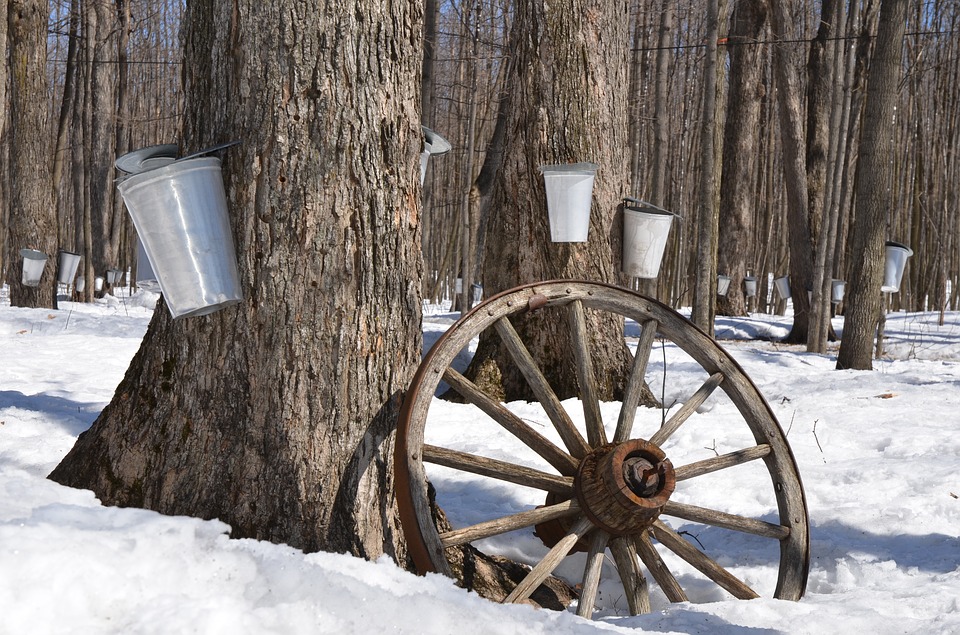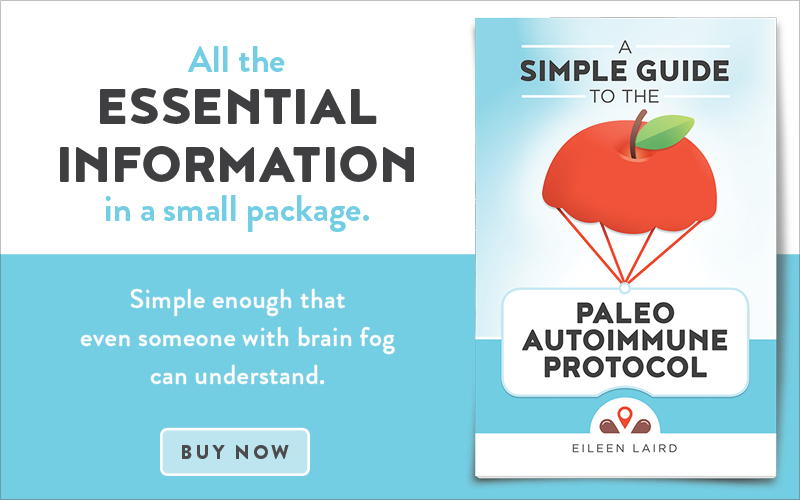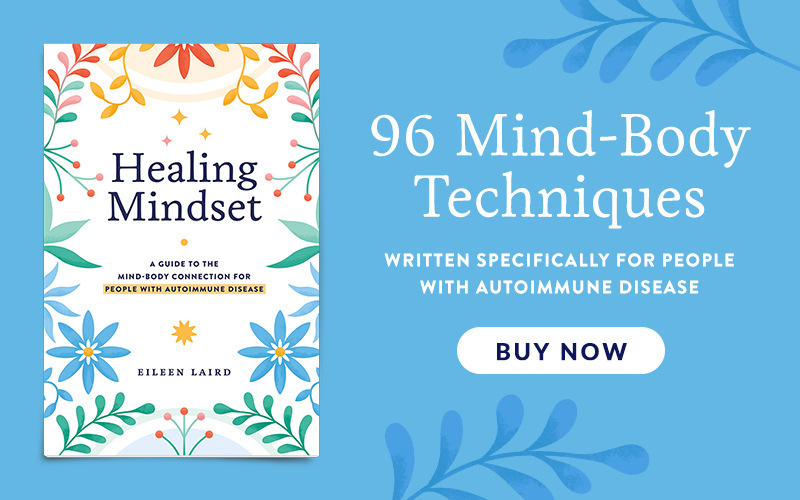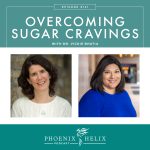
“What we eat, when we eat, and how much we eat affect a variety of hormones that interact with the immune system. When dietary factors (like eating too much sugar) dysregulate these hormones, the immune system is directly affected.”
~ Dr. Sarah Ballantyne
But I Only Eat Natural Sugars!
This is a common mistake people make when they switch to a healing diet. They simply replace refined sugars with natural ones, assuming those are healthy, and continue to make sweet treats a regular part of their life. Honey, maple syrup, and dried fruit may not be refined, but our bodies still process them as sugar and too much sugar in any form is inflammatory. That’s why the leaders of the paleo community warn against eating too much (no more than 1 teaspoon to 1 tablespoon per day). The problem is that moderating sugar can be hard. You start within the limits – a tiny taste here and there – and before you know it, paleo AIP desserts have become a core part of your daily diet and you’re eating dried fruit by the handful. Suddenly, you notice your healing progress has stalled or even started to move backwards. This doesn’t happen to everyone, but if it’s happening to you, it might be time for a “reset”.
Signs It Might Be Time to Rein In Your Sugar Intake
- Sugar cravings every day, often throughout the day
- Mood swings
- Energy crashes
- Feeling h’angry between meals (hungry and angry at the same time)
- Feeling shaky/jittery between meals
- Problems falling asleep or staying asleep
- Hormone imbalances
- Autoimmune activity even though you’re 100% AIP
Why I Decided to Do a Sugar Detox
My readers often put me on a pedestal and assume I would never fall into this AIP trap myself. Here’s the truth: I’m not perfect. One of the reasons I’m writing about this now is that I’ve always had a sweet tooth. While I eat far less now that I’m paleo, stressful times in my life can sometimes tap into old comfort food habits. Before I know it, I’m back on the sugar rollercoaster (only this time it’s honey-driven.) I was experiencing many of the signs I listed above. It was time to do a reset! Scroll to the bottom of this post to see my results.
My Sugar Detox Rules
When I decided to do a sugar detox, I was hoping I could just follow and promote one of the programs that already exist, but most of those encourage sugar-free baked treats and/or sugar-free sweeteners. I think the theory is that they help people over the hump of the sugar detox challenge. My concern is that these “crutches” can actually be an obstacle to change. In addiction recovery, they call it a transferred addiction. Can’t have refined sugar? Let’s replace it with natural ones. Can’t have those during the detox either? Let’s switch to stevia. Can’t bake your favorite dessert any more? Search pinterest for creative recipes that don’t use any added sweeteners at all. We still seek our comfort foods within the “rules” of the program, which means we never wean ourselves away from our sweet tooth. Instead, we just continue our old pattern in a new way. I think a program like this works best if it’s a mind/body/spirit endeavor. It’s a chance to not only reset our physiological cravings but also the psychology that drives those cravings. So, I made up my own set of rules. This isn’t a formal program. I’m not packaging, branding it, or selling it. You can follow these if they resonate with you, or make up your own set of rules if they don’t:
- No added sweeteners of any kind. This includes everything from honey and maple syrup to stevia and xylitol.
- No dried fruit.
- No baked goods (even sugar-free ones).
- Lemon and lime are the only juices allowed.
- No sweet beverages. This means no other fruit juice, no coconut water, no kombucha, and no water kefir. While those last three are often considered healthy foods in our community, they’re actually high in sugar, so they’re out during the detox.
- Limit fruit to 1 serving daily. Avoid extremely sweet fruits (such as pineapple and mango) and any fruit that triggers a desire to eat more and more. For me, grapes are like candy; once I have one, I want to eat the whole bowl. My personal favorites for the detox were grapefruit and blueberries. They’re low-glycemic and one serving felt satisfying to me. While avocado is technically a fruit, for the purposes of this detox it counts as a healthy fat that can combat cravings. So you don’t need to limit avocado.
- White potatoes and white rice aren’t allowed during the elimination phase of the paleo autoimmune protocol anyway, but if you have reintroduced them, I recommend removing them for this detox. They break down quickly into glucose in the body and are high-glycemic foods. While refrigeration does increase their resistant starch content, it only does this for a very small portion of it. The majority remains a simple starch, so there is no “refrigeration exception” to this rule.
- Alcohol also isn’t allowed on the AIP but many people reintroduce a glass of wine or hard cider successfully as occasional indulgences. While delicious, these are processed by the body as sugar, so they’re not allowed on this detox either.
- Eat 6-14 servings of non-starchy vegetables daily. This is the foundation of the AIP food pyramid. In addition to being filled with phytonutrients, they also help control hunger during this detox.
- Limit starches to 1 to 2 servings daily. People with autoimmune disease vary widely in their starch tolerance. People with ankylosing spondylitis often find they do well on a no-starch diet. I personally do best on a low-starch diet. And many people with Hashimoto’s need ample amounts of starch daily to feel their best. These aren’t hard and fast rules by diagnosis – we’re all unique. During the sugar detox, I recommend most people consume at least some starch, unless you know you don’t do well with it. Otherwise, you might accidentally slip into a ketogenic diet. That said, you don’t want to binge on starches since that can keep sugar cravings going and sometimes increase inflammation. Do some self-experimentation to discover the right amount of starch for you:
- High-starch AIP vegetables: parsnips, plantains, salsify, sweet potatoes, taro, yuca.
- Low-starch AIP vegetables: acorn squash, butternut squash, celeriac, delicata squash, jicama, kabocha squash, pumpkin, rutabagas, spaghetti squash, sunchokes, turnips.
- No-starch AIP vegetables: artichokes, arugula, asparagus, beets, bok choy, broccoli, broccolini, Brussels sprouts, cabbage, carrots, cauliflower, celery, chard, collards, cucumber, daikon, dandelion greens, endive, fennel, fiddleheads, garlic scapes, kale, kohlrabi, leeks, lettuce, mushrooms, mustard greens, nopales, okra, onions, radicchio, radishes, ramps, scallions, spinach, summer squash, watercress, zucchini.
- Looking for vegetable recipes? Check out my A-Z Vegetable Recipe Roundup.
What to Do When You Get Hungry
- Drink some water. Often thirst is misinterpreted by the body as hunger. Have a glass of water, and feel free to add some lemon, lime, or cucumber for added flavor.
- Don’t skip meals. You want to eat 3 large meals daily and include protein, vegetables and healthy fats with each one. When your blood sugar is stable, you’ll be able to go 4-5 hours between meals with no need for in-between meal snacks. At the start of your detox, snacks will likely be necessary as you slowly transition your body away from sugar as its preferred food.
- Don’t wait until you’re hungry to start cooking your next meal. Unless your meal is 100% leftovers, give yourself a little grace period. You don’t want to cook h’angry.
- Plan healthy snacks between meals. If you feel shaky, weak or dizzy, immediately have an in-between meal snack. This is a hypoglycemic state, and it’s not healthy. Some people never feel shaky; instead they feel h’angry (hungry and angry at the same time). As your blood sugar becomes more stable, you will slowly be able to extend your time between meals, but it’s absolutely fine to have healthy snacks between meals as you need them. Choose something sugar-free with both protein and fat. Here are some good choices:
- Avocado
- Sardines
- Meat patty with some raw veggies
- Liver paté on vegetable slices
- Chomps AIP-friendly beef sticks.
- Mini meal made from whatever leftovers are in the fridge
Craving Busters
- Meal plan to prevent cravings. Save your fruit and starch for later in the day. If you have them at breakfast, they can set off day-long cravings. A high protein breakfast with non-starchy vegetables and a healthy fat is ideal.
- Drink a cup of bone broth daily. I’m hungrier when I give up this daily habit. It seems to fill a nutritional need not met by other foods, and when I skip it, my body sends signals to eat until it receives those nutrients again.
- Enjoy a flavorful AIP drink. Try an AIP herbal tea, or water with lemon/lime juice.
- Cinnamon tastes sweet without being sweet. So feel free to add that to your drink or make these caramelized coconut chips for a snack.
- When craving something sweet, give yourself something sour instead. A spoonful of sauerkraut often stops the signal for me. So does celery.
- Distract yourself. Get outside, call a friend, open your coloring book, etc. Do something that takes your mind off food.
- Take a few deep breaths. Often, cravings come from a stress response. Breathing deeply activates our relaxation response.
- Emotional Freedom Technique. Also called EFT or tapping, this simple technique has been known to stop a craving in its tracks.
- Take the opportunity to get to know yourself and discover the patterns behind your cravings. Sometimes they’re food-related: you eat something sweet, you want more sweet. Sometimes, they’re hormone-inspired: you might crave sugar more right before or during your period. Sometimes the impulse is emotional: you reach for food to comfort and mask what you’re feeling. Other times it’s a stress-response: the cortisol makes you crave sugar. Knowledge is power. Identify the source of the craving, and know that you can consciously make a choice about how you respond. Over the course of the detox, as we make healthier choices in place of sugar, these cravings start to lose their power.
Mood Lifters and Healthy Comforts
- Get out in the sunshine. Sun is famous for creating vitamin D, a nutrient essential to autoimmune health. But did you know sunshine also boosts endorphins aka “happy hormones”? It’s one of the reasons it feels so good, and why many of us miss it during the short days of winter. If it’s rainy or cloud-covered outside, try a sun lamp instead.
- Make yourself laugh. Here’s a list of 25 Things to Make You Laugh. You can also do Laughter Yoga.
- Exercise. Research shows that exercise helps alleviate depression, whereas sugar makes it worse.
- Harness the power of touch. If you live with loved ones, ask for a hug. If you have a pet, enjoy the mutual comfort that comes from petting them.
- Put on some upbeat music. Check out this “happiness” playlist on Spotify.
- Meditate. Often when we’re feeling cranky, the last thing we want to do is meditate. But research shows that it’s an effective technique for alleviating depression, anxiety, and stress. There are lots of different ways to meditate. Find one that’s right for you.
- Relax in a bath. Epsom salt baths are one of my favorite self-care routines. They’re relaxing, detoxifying, and nurturing.
- Face and work through your emotions. If you are eating sugar to mask and avoid dealing with difficult emotions, they will often surface during this detox. This is an opportunity to address these feelings in a healthy way. This happened to me. Journaling is a great form of self-reflection. The Work by Byron Katie is a powerful technique for transforming negative thoughts and beliefs. And if the emotions that surface are overwhelming, seek out the help of a therapist. You are worth it.
- Added bonus: All of these things also help balance blood sugar by interrupting the stress response and boosting the relaxation and joy response instead.
Track How You Feel in Your Journal
Just like the paleo autoimmune protocol, a sugar detox is a science experiment focused on you. So, keep track and learn all you can! I have an article on how to keep a symptom journal. It doesn’t take a lot of time – just a few minutes per day. Through the process, you’ll notice all the different ways sugar impacts your health and wellness.
How Long Should You Do a Sugar Detox?
Anywhere from 2 weeks to 1 month is a good time period to break a bad habit and establish a new one. When you feel like you’ve gained information on how sugar impacts your life and your health, and your sugar dragon feels under control, you can stop the detox and mindfully move forward. The goal isn’t to stay at this level of restriction long-term. We want to find that healthy balance between eating in a way that supports our health without tipping over into orthorexia.
Reintroducing Natural Sugars
After the detox, hopefully your blood sugar has become much more stable, and your moods, energy levels and autoimmune symptoms have improved as well. Sugar is one aspect of autoimmune healing – it’s not the only influence. A sugar detox gives you the opportunity to see the specific role it plays in your personal health. Now, you get to loosen the reins a little bit and decide the role you want sugar to play going forward. The reintroduction process is a self-discovery process. Here are my tips:
- Only reintroduce one extra sugar per day. This lets you isolate its impact and watch how your body responds.
- Keep track in your journal. Note any changes, positive or negative, with each reintroduction. How does it impact your mood, your energy levels, your autoimmune symptoms, your cravings?
- Testing fresh fruits: Are you able to have just one serving, no matter the fruit? Or are there certain fruits that make you want to eat more and more?
- Testing dried fruit: Start by adding a little dried fruit to a savory recipe like kale with dried cranberries or chard with raisins. See how that feels, compared to eating a handful by itself.
- Testing desserts: Start with low-sugar desserts. Are they easier to moderate, or do all desserts make you want to eat the whole batch? How does your body respond physically and emotionally to a low-sugar dessert compared to a high-sugar one? What role do you want dessert to have in your life going forward?
- Testing moderation: On a healing diet like the AIP, the recommendation is to limit fruit to a few servings per day and natural sugars to no more than 1 teaspoon to tablespoon daily. Fruit contains healthy fiber and nutrition, and many people find it easier to moderate. When it comes to natural sugars like honey and maple syrup, it helps to know if you’re an abstainer or a moderator. Moderators do better if they allow themselves the occasional indulgence, so they’ll often keep dessert in the freezer. Abstainers have trouble stopping at one serving; they’d rather not have any at all. They wouldn’t keep dessert in the house, but might make an exception on their birthday when they can share it with a group. Knowing yourself lets you set yourself up for success.
- Test the timing: During the detox, we postponed fruits and starches until later in the day, because eating them at breakfast can set off cravings all day. Go ahead and test this for yourself and see if it’s true for you. Does it change depending on whether it’s fresh fruit, starch, or something sweet like maple syrup on paleo pancakes? The other recommendation for blood sugar management is to always eat sugar alongside a meal. You can test this hypothesis, too. See how you feel when you eat fruit or a sugary treat by itself. A lot of us need to learn through experience rather than advice, and the truth is we’re all unique. Some of us will have more sensitive blood sugar responses than others.
- Consider a glucose monitor. This gives you some extra data in addition to what you learn by tuning into your body. Testing your blood sugar first thing in the morning gives you a “fasting glucose level” which is a good overall reading of your blood sugar stability. During reintroductions, you can test your blood sugar 2 hours after eating something sweet. Healthy levels in the morning are below 99 (below 86 is even better). And 2 hours after a meal, healthy levels are below 120. For more information on blood sugar testing, here’s a great article from Chris Kresser. And Robb Wolf has a special carbohydrate testing protocol in his book, Wired to Eat, where you test each food by itself first thing in the morning to see the pure/maximum blood sugar response.
My Sugar Detox Experience
- I felt worse before I felt better. My moods, my digestion, my sleep all suffered in the beginning. Thankfully, I knew this was a common sign of sugar withdrawal and stayed strong. Further into the detox, I started feeling better.
- It impacted my sleep in two opposing ways. I got tired earlier at night, allowing me to naturally go to bed by 10pm, when usually I’m up until midnight. However, my sleep quality was worse during the detox. My body likes a slightly higher carbohydrate intake for steady sleep.
- While I still had mood swings, they were less frequent and less intense. As I approach menopause, I’ve been experiencing more intense moods. During the detox, my husband said, “You’re nicer when you’re off sugar!” Instead of feeling consumed and controlled by my moods, I could see through them. I was able to feel the mood descend while still being able to think clearly and make decisions about how I wanted to behave. They also tended to dissipate more quickly; they were like pastel versions of the moods I had on sugar. This was a huge improvement and one of the main motivations for the sugar detox. I love my husband; I don’t want to be mean!
- My energy levels stabilized, and I stopped being influenced by weather. This was fascinating. I’m someone who has always felt the impact of sunshine vs. a cloudy day pretty acutely. But during the detox, I didn’t. I had the same amount of energy no matter what. That’s a very peaceful feeling.
- My nutrient-density increased. I ate far more vegetables in place of the white rice and paleo treats I was indulging in before. It wasn’t that I didn’t eat vegetables before, but I probably hovered around 6-8 cups per day pre-detox, whereas during my detox that increased to 10-12 cups per day. Terry Wahls and Sarah Ballantyne would be proud!
- It had no impact on my rheumatoid arthritis symptoms. Many people with autoimmune disease discover that sugar drives autoimmune flares. That doesn’t appear to be true for me, but my autoimmune symptoms are also really well managed right now. If I was already flaring, sugar would likely exacerbate that effect.
- I learned that store-bought treats are my personal kryptonite. They tend to be higher in sugar than anything I make at home, and they also tap into old habits of junk food indulgences. I’ll save them for vacations.
- Fresh fruit doesn’t lead me to binge, but dried fruit’s a different story. I can easily go a few days with no fruit and than have 2-3 pieces another day, with no negative consequences. However, dried fruit’s like candy for me. Not only is it hard to moderate portions, it sets off sugar cravings. The one exception is that I can have dried fruit in savory dishes and it doesn’t have this effect.
- White rice sets off sugar cravings for me. While white rice isn’t AIP, I’ve been able to reintroduce it successfully, but my body definitely processes it as sugar. However, I really enjoy it with certain meals, like AIP curries. So, I’m limiting myself to 1 recipe each week (no more than 2 meals) and having it at dinnertime, so it finishes the day rather than sets the tone for the day. This is my “AIP balance.”
- Kombucha is a beneficial digestive aid for me. While kombucha may taste sour, it’s actually pretty high in sugar which is why it isn’t allowed during the sugar detox. I’ve always moderated my portion size to 1 cup of homemade kombucha with dinner. During the detox, I replaced that with some apple cider vinegar in water. Both are known to stimulate stomach acid in a beneficial way that kickstarts digestion. It turns out that my digestion works best with kombucha with my meal. So, I happily reintroduced that back into my diet.
- I used to be a dessert moderator but I’m becoming an abstainer. I’m able to bake some cookies without eating the whole batch in one day. Instead, I put them in the freezer, but here’s the catch: I don’t forget about them. They will call to me emotionally, and I’ll have one or two daily until they’re gone. That’s just more dessert than I want to eat on a regular basis. So, going forward I’ll save AIP desserts for special occasions and times when I can share them with friends. I’m giving up my freezer stash! The one exception is homemade chocolates – another food I’ve reintroduced successfully – and one that seems to have a beneficial impact on my mind/body/spirit in small quantities.
- I feel more peaceful, more aware, and more capable of meeting my needs. I said at the start of this article that a sugar detox is a chance to not only reset our physiology but also tune into the psychology behind our cravings and our choices. Since sugar wasn’t available as a “comfort measure” I had to look for other ways to boost my moods and manage my stress. And the tips I share above worked much better! So while I have reintroduced a little more sugar back into my life, I no longer turn to it for comfort. I have established healthier coping mechanisms through this process, and that feels like a gift.
Is a Sugar Detox Good for Everyone?
Actually, no. First of all, not everyone needs it. If you are able to moderate your sugar intake with the occasional treat, while still focusing your diet primarily on nutrient-dense choices, you don’t need a sugar detox. Secondly, some people in our community have a history of eating disorders, and when a diet becomes too restrictive it can trigger old patterns. If that’s you, this protocol can cause more harm than good.
You May Also Be Interested In
Credit: image at top of page from Pixabay. It’s maple trees getting tapped for syrup.











Is coconut milk allowed on this sugar detox plan?
Hi Amy. Yes, absolutely.
What about using maple syrup or honey in cooked meals versus baked goods? Should they also be eliminated?
When I did my sugar detox, I removed it from all recipes. Then, when I reintroduced, I started by adding it to cooked meals. I found that as part of a meal, it didn’t seem to tap cravings for me the way it did in a sweet dessert. But everyone’s different. It’s something worth experimenting with, to see what works for you.
Thanks for such a wealth of information! My sugar dragon is so powerful I need to go this! My IBS is fierce but does get better after a few days off sugar. I always go back to sugar though so I reason need to break the habit for my horomones and IBS. Thanks!
You’re welcome, Cherise. Here’s to taming that dragon for our health!
Wonderful article Eileen! As someone who is susceptible to overindulging in sweet treats, there are some great tips here. Thank you!
You’re welcome, Rory! I’ll continue to use these same tips myself, going forward. It’s a practice, for sure.
Shop bought snacks are my kryptonite too!!! That word really resonated with me. self awareness of what conditions our cravings and shopping habits so important. It is so easy to think I eat well at home and am out of the house all day , I feel like/iideserve/am peckish so it’s ok to have a bottle of kombucha/an AIP friendly bar of something etc. For me , it’s that self awareness of eating Patterns that is key. There will always be times when maybe there will be more consumption of some of the foods you have mentioned if you are travelling/an emergency etc but ability to stop as soon as that situation over is hard.
Natalie – yes! Self-awareness is so essential, and the first step to making healthier choices.
Thanks so much for this blog post vThis is very timely for me. I found that reintroducing nuts and seeds and chocolate led to my buying and eating lots of store bought treats. I also like to make AIP goodies at home. I started having more AI symptoms, as well as candida- related symptoms (itching in my ears, inflammation around my finger nails. I’ve been trying a low starch AIP, but I’m still eating sweet foods like dried fruit. I’m going to be traveling in early June, and that’s stressful enough, but when I get back, I plan to do a reset using your guidelines.
Colleen, I can relate. I also think salty nuts get sweet cravings going, and we end up eating too much of both. Enjoy your trip, and best wishes for a healthy reset when you get home.
Incredible article! Thank you for all the hard work you put into writing it.
Hi Trish. This was a long one, but an important one!
Wonderful post Eileen,thank you!
You’re welcome!
This is so eye opening and helpful. I’ll be starting my sugar detox this week. Thank you!
Best wishes, Carla! May you feel better and learn a lot through the process.
Thank you!